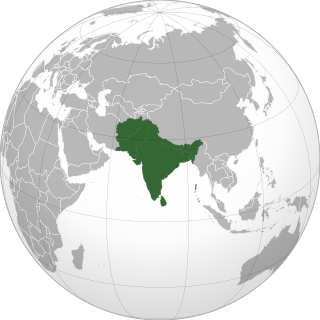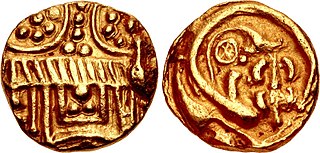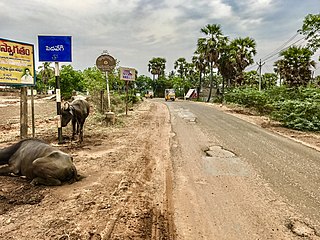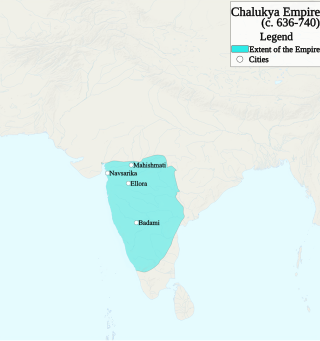
The middle kingdoms of India were the political entities in the Indian subcontinent from 230 BCE to 1206 CE. The period begins after the decline of the Maurya Empire and the corresponding rise of the Satavahana dynasty, starting with Simuka, from 230 BCE. The "middle" period lasted for almost 1436 years and ended in 1206 CE, with the rise of the Delhi Sultanate, founded in 1206, and the end of the Later Cholas.

East Godavari is a district in the Coastal Andhra region of Andhra Pradesh, India. Its district headquarters is at Rajamahendravaram.

The history of southern India covers a span of over four thousand years during which the region saw the rise and fall of a number of dynasties and empires.

The Pallava dynasty existed from 275 CE to 897 CE, ruling a significant portion of the Deccan, also known as Tondaimandalam. The Pallavas played a crucial role in shaping in particular southern Indian history and heritage. The dynasty rose to prominence after the downfall of the Satavahana Empire, whom they had formerly served as feudatories.

Kulottunga Chola I also spelt Kulothunga, born Rajendra Chalukya, was a Chola Emperor who reigned from 1070 to 1122 succeeding his cousin Athirajendra Chola. He also served as the Eastern Chalukya monarch from 1061 to 1118, succeeding his father Rajaraja Narendra. He is related to the Chola dynasty through his mother's side and the Eastern Chalukyas through his father's side. His mother, Ammangaidevi, was a Chola princess and the daughter of emperor Rajendra Chola I. His father was king Rajaraja Narendra of the Eastern Chalukya dynasty who was the nephew of Rajendra and maternal grandson of Rajaraja Chola I. According to historian Sailendra Nath Sen, his accession marked the beginning of a new era and ushered in a period of internal peace and benevolent administration. He was succeeded by his son Vikrama Chola

The Chola dynasty was a Tamil dynasty originating from southern India. At its height, it ruled over the Chola Empire, an expansive maritime empire. The earliest datable references to the Chola are from inscriptions dated to the 3rd century BCE during the reign of Ashoka of the Maurya Empire. The Chola empire was at its peak and achieved imperialism under the Medieval Cholas in the mid-9th century CE. As one of the Three Crowned Kings of Tamilakam, along with the Chera and Pandya, the dynasty continued to govern over varying territories until the 13th century CE.
Pulakeshi II popularly known as Immaḍi Pulakeśi, was the greatest Chalukyan Emperor who reigned from Vatapi. During his reign, the Chalukya empire expanded to cover most of the Deccan region in peninsular India.

The Vishnukundina dynasty was an Indian dynasty that ruled over parts of present-day Andhra Pradesh, Telangana, Odisha, and other parts of southern India between the 5th and 7th centuries. They emerged as an independent power during the reign of Madhava Varma, who conquered coastal Andhra from the Salankayanas and established their capital at Denduluru near Eluru. Their rule significantly shaped the history of the Deccan region. However, their reign ended with the conquest of eastern Deccan by the Chalukya king Pulakeshin II, who appointed his brother, Kubja Vishnuvardhana, as viceroy. Vishnuvardhana later declared independence, founding the Eastern Chalukya dynasty.

The Salankayana dynasty of ancient India ruled a part of Andhra region in India from 300 to 440 CE. Their territory was located between the Godavari and the Krishna rivers. Their capital was located at Vengi, modern Pedavegi near Eluru in West Godavari district of Andhra Pradesh.
Athirajendra reigned for a very short period of few months as the Chola king succeeding his father Virarajendra. His reign was marked by civil unrest, possibly religious in nature. Athirajendra was last clan of Chola dynasty. He was killed in the religious chaos. Athirajindra and Virarajendra interfered in the Vengi succession disputes after the Vengi king Rajaraja Narendra, who was closely related to the Chola clan through his mother Kundavai, a daughter of Rajaraja Chola, died in 1061 CE. The Vengi throne went to Saktivarman II in a palace coup. The Cholas wanted the Chola influence re-established in Vengi. Saktivarman II was killed, but Vijayaditya, Saktivarman's father assumed the throne and repulsed the Chola attempts at unseating him. Vijayaditya however accepted to serving as a Chola vassal.

The Chola Empire, which is often referred to as the Imperial Cholas, was a medieval thalassocratic empire based in southern India that was ruled by the Chola dynasty, and comprised overseas dominions, protectorates and spheres of influence in southeast Asia.

Eastern Chalukyas, also known as the Chalukyas of Vengi, were a dynasty that ruled parts of South India between the 7th and 12th centuries. They started out as governors of the Chalukyas of Badami in the Deccan region. Subsequently, they became a sovereign power, and ruled the Vengi region of present-day Andhra Pradesh until c. 1001 CE. They continued ruling the region as feudatories of the Medieval Cholas until 1189 CE.
Satyashraya, also known as Sattiga or Irivabedanga, was a king of the Western Chalukya Empire. During a time of consolidation of the empire in the early 11th century, Satyashraya was involved in several battles with the Chola dynasty of Thanjavur, the Paramara dynasty and Chedi Kingdom of central India, and the Chaulukyas of Gujarat. The results of these wars were mixed, with victories and defeats. Even as a prince, during the rule of his father Tailapa II, Satyashraya had established himself as an ambitious warrior. Satyashraya patronised the great Kannada poet Ranna who compared his patron favourably to the Pandava prince Bhima for his strength and valor in his epic poem Sahasabhimavijaya. Satyashraya held such titles as Akalavarsha, Akalankacharita and Sahasabhima.

Jayasimha II succeeded his brother Vikramaditya V on the Western Chalukya throne. He had to fight on many fronts, against the Cholas of Tanjore in the south and the Paramara dynasty in the north, to protect his kingdom. His rule however was an important period of development of Kannada literature. The Brahmin Kannada writers Durgasimha, Chavundaraya II and Kavitavilasa were in his patronage. Chandraraja, a Brahmin writer on erotics was in the court of Machiraja, a vassal of Jayasimha II. The Jain Sanskrit scholar Vadiraja was in Jayasimha II's court and wrote two epics, on logic, and a commentary on an earlier Jain text. His queen Suggaladevi was a disciple of the Kannada saint-poet Devara Dasimayya.

Someshvara I was a king of the Western Chalukyas. Also known as "Ahavamalla" or "Trilokamalla", Someshvara succeeded his father Jayasimha II to the throne.
Kubja Vishnuvardhana I "Vishama-Siddhi" whose Kannada name was Bittarasa was the brother of Chalukya Pulakeshin II. Vishnuvardhana I ruled the Vengi territories in eastern Andhra Pradesh as the viceroy under Pulakeshin II from around 615 AD. Eventually, Vishnuvardhana declared his independence and started the Eastern Chalukya dynasty in AD.

The recorded history of Andhra Pradesh, one of the 28 states of 21st-century India, begins in the Vedic period. It is mentioned in Sanskrit epics such as the Aitareya Brahmana. Its sixth-century BCE incarnation Assaka lay between the Godavari and Krishna Rivers, one of sixteen mahajanapadas. The Satavahanas succeeded them, built Amaravati, and reached a zenith under Gautamiputra Satakarni.

Pedavegi is a village in Eluru district in the state of Andhra Pradesh in India, 10 km north of Eluru. It is administered under Eluru revenue division. Pedavegi also serves as the mandal headquarters of Pedavegi mandal. The nearest railway station is Denduluru (DEL) located at a distance of 9.15 km.

The Chalukya dynasty was a Classical Indian dynasty that ruled large parts of southern and central India between the 6th and the 12th centuries. During this period, they ruled as three related yet individual dynasties. The earliest dynasty, known as the "Badami Chalukyas", ruled from Vatapi from the middle of the 6th century. The Badami Chalukyas began to assert their independence at the decline of the Kadamba kingdom of Banavasi and rapidly rose to prominence during the reign of Pulakeshin II. After the death of Pulakeshin II, the Eastern Chalukyas became an independent kingdom in the eastern Deccan. They ruled from Vengi until about the 11th century. In the western Deccan, the rise of the Rashtrakutas in the middle of the 8th century eclipsed the Chalukyas of Badami before being revived by their descendants, the Western Chalukyas, in the late 10th century. These Western Chalukyas ruled from Kalyani until the end of the 12th century.
The Battle of Vijayawada was fought in 1068 between the Chola army under Virarajendra Chola and the Western Chalukya army commanded by Vikramaditya VI near the present-day city of Vijayawada in Andhra Pradesh, India. The war resulted in the recovery of Vengi Andhra by the Cholas and coronation of Vijayaditya VII as Eastern Chalukya ruler by Virarajendra Chola.












